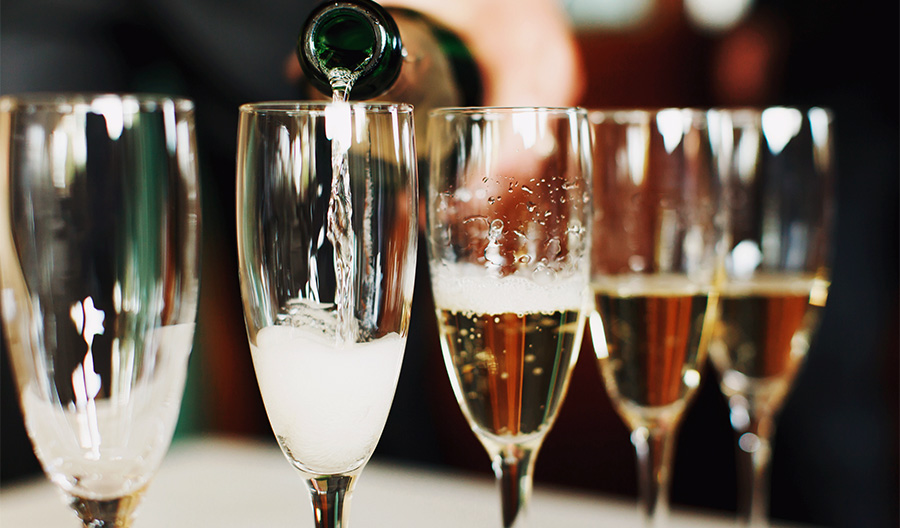Champagne or prosecco: tomato, tomahto, right? Not quite. Although the names of these two types of sparkling wine often are used interchangeably, these styles of wine are in fact distinct from each other in a number of significant ways. This is what to know when choosing prosecco vs. Champagne.
What Is Prosecco?
Prosecco is a type of sparkling wine crafted in the Veneto region of Italy. The main grape used in prosecco production is glera, which must compose a minimum of 85% of the wine. Prosecco is made via the Charmat method, otherwise known as the tank method, in which the wine undergoes a secondary fermentation in a pressurized vat to create its bubbles. On the palate, prosecco is bright and fresh, and it is generally best consumed within the first few years after it’s made. Most prosecco is bottled young and as a non-vintage wine, which is to say, they are made from blends of base wines from multiple years.
What Is Champagne?
Champagne is a style of sparkling wine made in the Champagne region of northeastern France. The main grapes of the region are chardonnay, pinot noir, and pinot meunier; a handful of lesser-known varieties are also permitted, though these are rarely used. To achieve its bubbles, Champagne is produced via the “traditional” method, otherwise known as the méthode champenoise, which involves allowing the wine to undergo a secondary fermentation in the bottle. The wine then ages for a minimum of 12 months on the lees in the bottle, which adds texture, complexity, and toasty notes. Less-expensive Champagnes are often non-vintage, while vintage Champagne, made with wine from a single year’s harvest, is available and often more expensive.
Champagne is produced in a variety of styles, from bone-dry, called brut nature or zero dosage, to sweet, referred to as demi-sec. The structure and acidity found in Champagne means these wines can either be consumed immediately after they are released for sale or “cellared” to age them, which adds complexity to the wine’s flavors.

How Are Prosecco and Champagne Similar?
Both are sparkling wines, both types are made in Europe, and both are delicious! Aside from those factors, however, the two styles of sparkling wine are in fact quite distinct from each other.
What Are the Biggest Differences between Prosecco and Champagne?
The most significant differences between prosecco and Champagne are that they are made in different countries and use different grapes and production methods. These factors also cause them to taste quite different from each other, and they have different textures as well. Sparkling wines made via the Charmat method, as prosecco is, tend to have bigger bubbles, whereas traditional-method sparklers, such as Champagne, have finer ones, or what’s sometimes referred to as a more delicate mousse.
How Else Are Prosecco and Champagne Different from Each Other?
With regard to flavor, prosecco tends to be much more fresh and bright. While many Champagnes often have fresh fruit flavors, too, these wines tend to have more complex flavor profiles and also show notes of toast, baking spice, and cream, which develop during their longer aging times.
Champagne also tends to be more structured than prosecco, making these wines much more age-worthy in the cellar. Most prosecco is meant to be consumed within the first few years of production; well-crafted Champagne, on the other hand, can age for decades.
Lastly, because of the more complex production methods used to make it, Champagne generally costs significantly more than prosecco.
When Is It Better to Choose Prosecco vs. Champagne—or Vice Versa?
For fruit-forward, budget-friendly bottles to drink in the near future, prosecco is an excellent choice. It’s great for popping open whenever you like, enjoying with big groups, and even mixing into cocktails. For something with more complexity and elegance, or if you want to cellar a bottle to revisit it down the line, Champagne should be your bubbly of choice.
Which Prosecco or Champagne Should I Buy?
Prosecco’s lower price point makes it great for exploring and trying different bottles. Some producer names to keep an eye out for include Bisol, Riondo, Sommariva, and Sorelle Bronca.
Champagne comes in a much wider range of options and price points, so the stakes are higher for choosing the right bottle.
Champagne producers can be broken down into two categories: Champagne houses and what’s known as “grower Champagne.” Champagne houses produce large quantities of wine every year and are generally very well-known. In addition to using grapes grown on their own estates, Champagne houses also purchase grapes from smaller farmers across the region. Producers in this category include Krug (a splurge, but a worthwhile one), Ruinart, and Billecart-Salmon, which is particularly renowned for the rosé version of its Champagne.
Grower Champagne producers, however, use only grapes from vineyards that they own and farm themselves. These producers are referred to as récoltant-manipulant in French and can be identified by the RM on their labels. Bérêche & Fils is an excellent example of this category, and Laherte Frères, while technically a negociant (meaning it purchases grapes to make its Champagne, although in this case, all grapes are purchased from vineyards belonging to family members), is in practice a grower producer.

